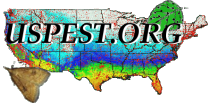

This model is an implementation of the Smith version of the potato-tomato late blight model (PTLB), which uses weather data to calculate hourly and cumulative risk index values that estimate favorability of conditions for infection and generation time of the fungus Phytophthora infestans, the causal agent of PTLB disease.
This app is a newer, streamlined interface for the existing model, which is also available through MyPest Page.
Select the "Inputs" tab, search for weather stations near you, and choose one either from a list or a map. Be aware that some weather stations have poor quality or missing data. Our software estimates the quality of each station, but you may wish compare results for several nearby stations.
Optionally, you may choose a start date and a span (number) of days. If you leave the start date blank, the end of the output will be five days in the future, using forecast weather data, and the app will count back to a start date in the recent past. The weather forecast data is from the National Weather Service's "NDFD" forecasts.
Then, select "Graph" or "Table" to run the model. Your output will appear after 10-20 seconds depending on server load.
PTLB infection risk by P. infestans can be predicted based on leaf wetness and temperature for a given area. This model predicts the risk of infection based on consecutive hours of wetness (which are estimated from relative humidy directly, or from a function of temperature, dewpoint, and wind speed), temperature, and the duration of these events, and assigns cumulative risk points and a risk category:
The index assumes that inoculum (active spores) are present nearby. The risk index is appropriate for use on highly susceptible cultivars and may be overestimated on less susceptible cultivars. These categories can be used to guide fungicide applications or other management actions such as fungicide selection and intensity of scouting.
Information on late blight is available for potatoes and tomatoes from Pacific Northwest Disease Management Handbook. Technical information about the disease and the model is available on our disease risk model documentation page.
Disclaimer: The index is intended to inform your decisions about management actions, such as choice and timing of control measures and intensity of scouting. It should supplement, not replace, the other factors you consider in making these decisions. Use at your own risk.
Automated email delivery of the disease risk index outputs displayed in this app is available at no cost. An email subscription offers model results for this and several other plant disease models, for up to three weather stations, on a schedule that you select. To subscribe, you will need a uspest.org account.
Next, use one of these buttons to run the model and see the output in the form of your choice.
To get this information by email, log in to or sign up for USPEST.org email notifications. To see the model output together with relevant weather inputs, go to MyPest Page.
To get this information by email, log in to or sign up for USPEST.org email notifications. To see the model output together with relevant weather inputs, go to MyPest Page.